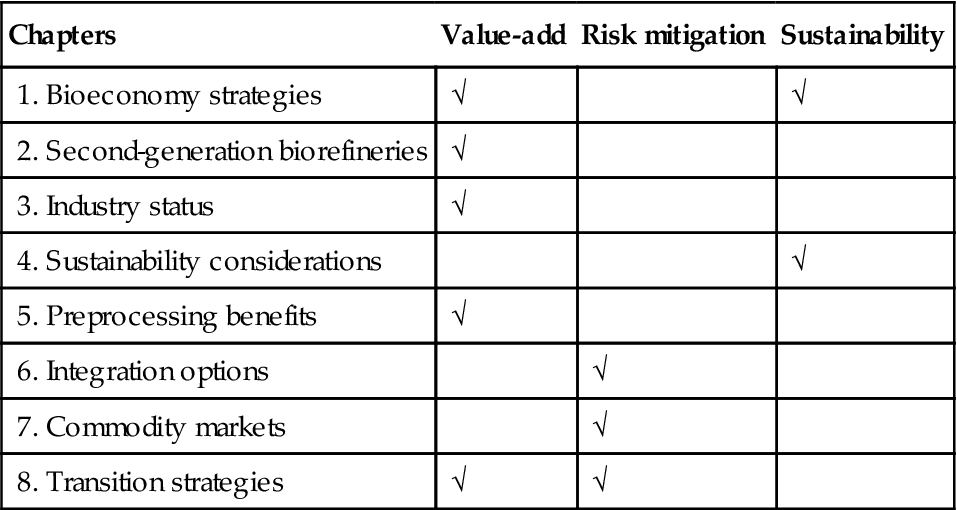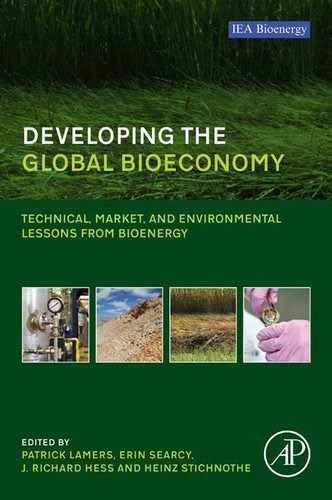Conclusions
P. Lamers1, E. Searcy1, J.R. Hess1 and H. Stichnothe2, 1Idaho National Laboratory, Idaho Falls, ID, United States, 2Thünen Institute of Agricultural Technology, Braunschweig, Germany
Introduction
Global primary energy supply is dominated by fossil fuels, accounting for 81% in 2013 (IEA, 2015). Growing global energy needs, due to rising incomes and population trends, project an increase in the use of fossil fuels over the coming decades (IEA, 2014). Fossil fuel usage however has been identified to be one of the key sources of greenhouse gas (GHG) emissions and thus a major contributing factor to anthropogenic climate change (IPCC, 2014). One of the key challenges in the energy sector for this century will therefore be to decouple a growing energy supply from an increase in GHG emissions. Bioenergy has been regarded as one of the options to address this challenge. It already forms an integral part of many sectors, such as biomass systems for food, fodder, fiber, and forest products. In 2013, bioenergy contributed around 10% to the global primary energy supply (IEA, 2015). While the majority of this volume still accounts for traditional biomass use, a little over a third represents the use of biomass for heat and power generation or its conversion into road transportation fuels in industrialized countries, typically coined “modern” usage (IEA, 2014; IPCC, 2014).
Expert reviews of available scientific literature predict potential primary biomass deployment levels of up to 300 EJ by 2050 (Chum et al., 2011). A recent IEA Bioenergy analysis of five globally significant supply chains, including boreal and temperate forests, agricultural crop residues, biogas, lignocellulosic crops, and cultivated grasslands and pastures in Brazil, has confirmed that feedstocks produced via logistically efficient production systems can be mobilized to make significant contributions to achieving global targets for bioenergy by 2050 (IEA-Bioenergy, 2015).
Scope
While modern bioenergy deployment levels are heterogeneous across the globe, in some markets, it has already been part of the national fuel mix for several decades. The specific drivers for its deployment vary from country to country and have, due to different policy frameworks, industry structures, and natural circumstances (eg, growing conditions), led to the development of distinct supply chains (eg, feedstock choices) and markets (eg, specific sectors). It is on these markets and lessons learned that this book focuses on.
Despite the vast amount of politically driven strategies, there is still little understanding on how current markets will transition towards a national and essentially global bioeconomy. The transition from an economy based on fossil raw materials to a bioeconomy obtaining its raw materials from renewable biological resources requires concerted efforts by international institutions, national governments, and industry sectors, and prompts for the development of bioeconomy policy strategies.
This joint analysis brings together expertise from three IEA Bioenergy subtasks, namely Task 34 on Pyrolysis, Task 40 on International Trade and Markets, and Task 42 on Biorefineries. The underlying hypothesis of the work is that bioeconomy market developments can benefit from lessons learned and developments observed in modern bioenergy markets. The question is not only how the bioeconomy can be developed, but also how it can be developed sustainably in terms of economic (eg, risk reduction and piggy-backing on existing industry) and environmental concerns (eg, nonfood biomass based).
The strength of bringing three IEA Bioenergy subtasks into this analysis is found in each task’s area of expertise. Tasks 34 and 42 identify the types of biorefineries that are expected to be implemented and the types of feedstock that may be used. Task 40 provides complementary work including a historical analysis of the developments of biopower and biofuel markets, integration opportunities into existing supply chains, and the conditions that would need to be created and enhanced to achieve a global biomass trade system supporting a global bioeconomy. It is expected that a future bioeconomy will rely on a series of tradable feedstock intermediates, that is, commodities. Investigating the prerequisites for such a commoditization, and lessons learned by other industries, play a central role in this analysis.
The analysis covers an overview of biorefineries in a global biobased economy, identifies feedstock and conversion pathways, and outlines the status of demonstration plants and underlying economics. It brings together lessons learned and case studies from the biopower and biofuel markets and covers a brief historical description of international bioenergy trade and markets and links these and future developments to biomass preprocessing options. Furthermore, it bridges current to future bioeconomy-related markets by identifying and describing logistical integration opportunities. Several case studies of existing supply chains in the bioenergy markets are analyzed with respect to increased volume and end-use markets.
Within the context of this work, bioeconomy is defined as the economic, environmental, and social activities associated with the production, harvest, transport, preprocessing, conversion, and use of biomass for biopower, bioproducts, and biofuels. As such a bioeconomy refers to the set of economic activities that relate to the invention, development, production, and use of biological products and processes (OECD, 2009). The main industrial sectors likely to be involved in the future bioeconomy are agriculture and forestry, and include their related processing industries (eg, food and feed, pulp and paper, etc.), plus chemicals and materials (Bell et al., 2014; NEA, 2014). While the production of biobased materials is not new, the majority of fuels, nitrogen fertilizer, organic chemicals, and polymers are still derived from fossil-based feedstock, predominantly oil and gas.
Lessons From Bioenergy
Whether the product is an energy carrier such as biofuel or biopower, or a biomaterial or biochemical, its production requires biomass as a feedstock. Many factors impact the selection of biomass feedstock: the total delivered cost and availability of the biomass, the quality required by the conversion process which may align with one biomass type better than another, as well as the underlying requirement for sustainability. Also, all of these factors are interrelated; a more robust conversion process may be able to use a broader range of feedstocks, increasing biomass availability and potentially decreasing sourcing costs. However, robustness is only one consideration when selecting a conversion process. Additional considerations include (but are not limited to) total capital cost, per-unit production cost, state of technology development of the bioeconomy process, as well as its comparable conventional processes. Also, different conversion processes yield different products, and therefore the desired product (and the markets, existing and anticipated) for these products must be a key consideration. An option that has many advantages is the “integrated biorefinery” approach, accepting a variety of feedstocks and producing a variety of outputs depending on current market and feedstock outlooks.
An opportunity exists to leverage existing infrastructure and technologies, developed and proven by other industries, such as grain and petroleum. Using high-capacity, economic transport and handling equipment developed through these other industries could immediately enhance the efficiency of biomass logistics systems. However, this infrastructure was developed to move dense, flowable, consistent material (whether solid or liquid), characteristics which raw biomass often does not have under current agricultural supply systems. Is it an option to transform raw, unstable, bulky biomass into a flowable commodity like grain or petroleum?
The commoditization of biomass feedstock offers many potential benefits, including access to multiple markets (for both producers to sell into and biorefiners to purchase from), standardization of quality, and price stabilization. Lessons learned from the many other industries that have undergone commoditization (eg, grain and oil), and lessons learned from those which have not (such as coal), can be weighed to establish the best path forward. Raw biomass, currently not a commodity, will require significant investment to transition from the current supply system of the agricultural industry and markets to a commodity-type multiple market system.
Across this book, three themes emerge as fundamental to bridging the gap from the current, bioenergy-focused system to an integrated bioeconomy: value-add, risk mitigation, and performance metric (Table 1).
Table 1
Main themes and their representation across the book
| Chapters | Value-add | Risk mitigation | Sustainability |
| 1. Bioeconomy strategies | √ | √ | |
| 2. Second-generation biorefineries | √ | ||
| 3. Industry status | √ | ||
| 4. Sustainability considerations | √ | ||
| 5. Preprocessing benefits | √ | ||
| 6. Integration options | √ | ||
| 7. Commodity markets | √ | ||
| 8. Transition strategies | √ | √ |

The value proposition across the supply chain from the biomass grower, to the preprocessing and conversion industry is required to mobilize resources and create market and trade options. Value-add can be achieved in several ways, for example, enhanced market value due to improved product properties or by more favorable political framework conditions through, for example, carbon pricing. Wood pellets are a key example of value-add through preprocessing, creating lower moisture, higher flowability, higher energy and bulk density intermediates that can access larger markets—geospatially and temporally.
On the implementation side, large-scale biomass investment projects face systematic (wider market/economic) as well as nonsystematic, project-immanent risk. The latter can be mitigated (among others) by plant design and process integration. This book presents market as well as technical integration options, for example, how utilizing existing logistical infrastructure can be leveraged by emerging supply chains. It analyzes factors necessary for commoditization and presents the linkage between merchandisable, tradable, and commodity-type feedstock intermediates.
Sustainability is the key performance metric in the global bioeconomy. Intermediates and final products have to adhere to higher environmental standards than their often fossil-fuel-based substitutes. Eventually, when respective framework conditions level the playing field for products of the global bioeconomy, they will become available to consumers at equal costs, which will drive their demand and deployments.
